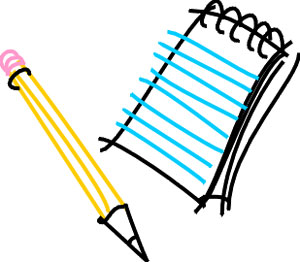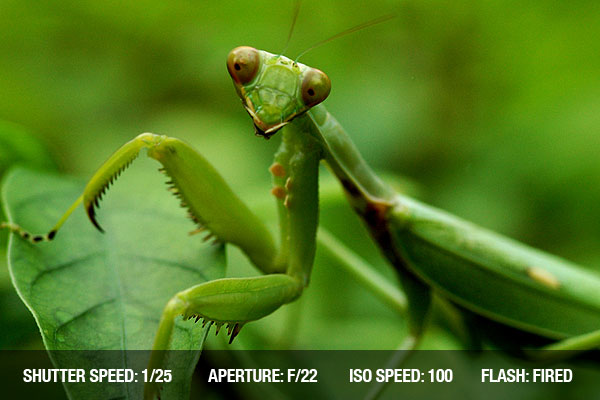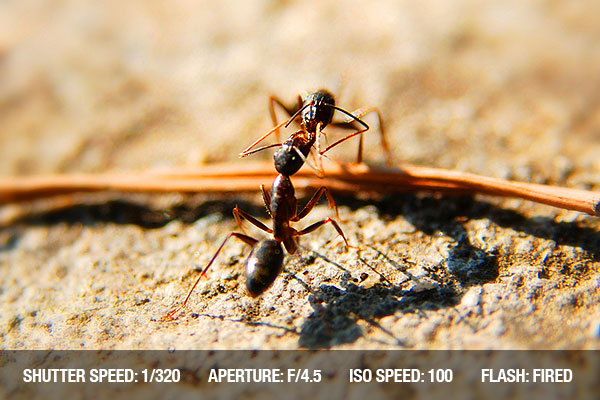Orangutan In The Rain
Indonesia-based Photographer Andrew Suryono shares of his magical photo, “I was taking pictures of some Orangutans in Bali and then it started to rain. Just before I put my camera away, I saw this Orangutan took a banana leaf and put it on top on his head to protect himself from the rain!” Without second thought Andrew reached for his DSLR and captured the moment.

1. Shooting modes
The best place to start is with shooting modes. The shooting modes will most likely be found on a dial labelled with ‘auto, Av, Tv, P, M’ and maybe more. Selecting a shooting mode will determine how your camera behaves when you press the shutter, for example, when ‘auto’ is selected, the camera will determine everything to do with the exposure, including the aperture and shutter speed. The other modes, ‘Av, Tv, P, M’, are there to give you control:

Don’t worry if your mode dial looks a little different; different manufacturers use different abbreviations for the shooting modes. Your mode dial may have the letters ‘A, S, P, M’ (instead of Av, Tv, P, M), yet they all function in the same way. Below, I have given each abbreviation for the given mode.
Aperture Priority (Av or A)
Aperture priority can be thought of as a ‘semi-automatic’ shooting mode. When this is selected, you as the photographer set the aperture and the camera will automatically select the shutter speed. So what is aperture and when would you want to control it?
The aperture is the size of the opening in the lens through which light is allowed to pass whenever the shutter is opened – the larger the aperture, the more light passes through.
The aperture is measured in ‘f-stops’ and is usually displayed using an ‘f-number’, e.g. f/2.0, f/2.8, f/4.0, f/5.6, f/8.0 etc, which is a ratio of focal length over diameter of the opening. Therefore, a larger aperture (a wider opening) has a smaller f-number (e.g. f/2.0) and smaller aperture (a narrower opening) has a larger f-number (e.g. f/22). Reducing the aperture by one whole f-stop, e.g. f/2.0 to f2/8 or f/5.6 to f/8.0, halves the amount of light entering the camera.

Aperture is one of the most important aspects of photography as it directly influences the depth of field – that is, the amount of an image that is in focus. A large depth of field (achieved by using a small aperture (large f-number)) would mean that a large distance within the scene is in focus, such as the foreground to the background of the landscape below.

An aperture of f/13 was used here to give a large depth of field, ensuring that the whole image, from the foreground grasses to the background mountains. was sharp
Whereas a shallow depth of field (achieved by using a large aperture (small f-number)) would produce an image where only the subject is in sharp

به دلیل استقبال و توجه خوانندگان هنردوست و هنرمند به سری مقالات 'چگونه یک اثر هنری را تجزیه و تحلیل کنیم؟' در ادامهی ارائه روش تجزیه و تحلیل نقاشی، به 'روش تجزیه و تحلیل عکس' نیز میپردازم. در مقالات آتی با انتخاب عکسی مناسب با کمک و همراهی شما خوانندهی فرهیخته به تجزیه و تحلیل آن خواهم پرداخت. پیشنهادات و مشارکت صمیمانهی شما عزیران را تمنا دارم.
"نگاه تو مهم است، نه در آنچه مینگری." – آندره ژید (مائدههای زمینی)
گام اول:
توصیف عکس: شامل شرح موضوع عکس و صحبت از محیط اتفاقی عکس است. اطلاعاتی دربارهی عکاس، زمان عکاسی و محیط اجتماعی که عکس از دل آن سربرآورده است. این مرحله مهم است زیرا باعث گردآوری اطلاعاتی است که به درک عکس کمک میکند.
توصیف یعنی گفتن و نوشتن از آنچه که به ... ادامه مطلب...
.: Weblog Themes By Pichak :.








 آمار
وب سایت:
آمار
وب سایت:


